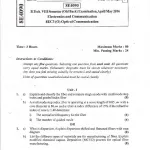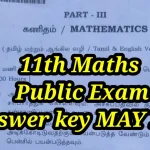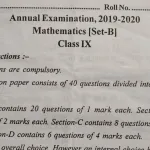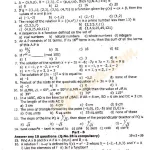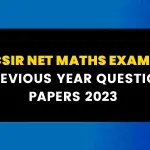What is force and how does it affect the motion of an object?
Force is a push or pull on an object that can change its speed, direction, or shape.
Define inertia with an example.
Inertia is the tendency of an object to resist changes in its state of motion. A book resting on a table stays at rest unless moved.
What is Newton’s First Law of Motion?
It states that an object remains at rest or in uniform motion unless acted upon by an external force.
State Newton’s Second Law of Motion.
It explains that the force acting on an object is equal to the mass of the object multiplied by its acceleration.
What is momentum?
Momentum is the product of the mass and velocity of an object and indicates how much motion it has.
What is the unit of force in the SI system?
The SI unit of force is the newton (N).
Explain the concept of balanced and unbalanced forces.
Balanced forces do not change an object’s motion, while unbalanced forces do.
Why do passengers fall forward when a bus suddenly stops?
Due to inertia, their bodies tend to stay in motion even though the bus has stopped.
State the law of conservation of momentum.
It says that the total momentum of two objects before and after a collision remains the same if no external force acts on them.
What is the relationship between mass and acceleration?
More mass results in less acceleration for the same amount of force.
How does friction affect motion?
Friction opposes motion and slows down moving objects.
Give an example of useful friction.
Friction between shoes and the ground helps us walk without slipping.
What is kinetic energy?
Kinetic energy is the energy possessed by a moving object.
What is potential energy?
Potential energy is stored energy an object has because of its position.
What are the factors affecting potential energy?
Mass, gravity, and height of the object.
Give an example of conversion of potential energy to kinetic energy.
A stone falling from a height converts its potential energy to kinetic energy.
What is power in physics?
Power is the rate at which work is done or energy is transferred.
Define work with an example.
Work is done when a force moves an object in the direction of the force, like lifting a bag.
What is the unit of energy?
The SI unit of energy is the joule (J).
What is one watt?
One watt is the power when one joule of work is done in one second.
What are simple machines?
Devices that make work easier by changing the direction or magnitude of force.
Name two simple machines.
Lever and pulley.
How does a pulley make work easier?
It allows lifting heavy loads by changing the direction of force.
What is gravitational force?
The force of attraction between two objects due to their mass.
Why do objects fall to the ground?
Because Earth exerts a gravitational force on them.
State the acceleration due to gravity on Earth.
It is approximately 9.8 meters per second squared.
What is the weight of an object?
Weight is the force of gravity acting on an object’s mass.
How is weight different from mass?
Mass is the amount of matter, while weight is the force of gravity on that mass.
Can weight change from place to place?
Yes, weight changes with gravity, which varies slightly from place to place.
What is pressure?
Pressure is the force applied per unit area.
What is the unit of pressure?
The SI unit of pressure is pascal (Pa).
Why do sharp knives cut better?
Because they apply more pressure due to smaller surface area.
How does a hydraulic lift work?
It uses liquid pressure to lift heavy objects with small force.
What is the principle of floatation?
An object floats if it displaces water equal to its weight.
Why does ice float on water?
Because ice is less dense than water.
What is the density of water?
The density of water is 1 gram per cubic centimeter or 1000 kg/m³.
What is Archimedes’ Principle?
It states that a body immersed in a fluid experiences an upward force equal to the weight of the fluid displaced.
What is atmospheric pressure?
It is the pressure exerted by the weight of the atmosphere.
Why do ears pop during take-off in an airplane?
Due to the sudden change in atmospheric pressure.
What is a barometer?
An instrument used to measure atmospheric pressure.
Define thrust.
Thrust is the total force acting perpendicular to a surface.
What is the difference between thrust and pressure?
Thrust is the total force, while pressure is thrust per unit area.
Why are wide tyres used in tractors?
They reduce pressure on the ground, preventing sinking into soft soil.
What is buoyant force?
An upward force exerted by fluids on objects placed in them.
What happens to pressure with depth in a liquid?
Pressure increases with depth.
Why do astronauts wear pressurized suits?
To protect them from low atmospheric pressure in space.
How does pressure affect the boiling point of liquids?
Higher pressure increases the boiling point.
What is the speed of sound in air?
Approximately 343 meters per second at room temperature.
Does sound travel faster in solids or gases?
Sound travels faster in solids because particles are closer together.
What is echo?
An echo is a reflected sound wave heard after the original sound.
What is the minimum distance to hear an echo?
About 17 meters, so the reflected sound reaches back after 0.1 seconds.
Recommended Indian Books for 9th Class Physics SA1 Question Paper 2018 Preparation
-
Comprehensive Physics Class 9 – By Laxmi Publications, Author: Laxmi Singh
Covers chapter-wise explanations, solved examples, and a large collection of objective and subjective SA1 practice questions with solutions. -
CBSE Chapterwise Solutions Class 9 Science (Physics Section) – By Arihant Experts, Arihant Publications
Offers previous years’ questions grouped by chapters, with detailed step-by-step solutions and SA1-focused practice sets. -
Foundation Science Physics for Class 9 – By H.C. Verma, Bharati Bhawan Publishers
Presents clear explanations of physics concepts, numericals in easy language, and includes short and long answer questions ideal for SA1 exams. -
Together With Science Class 9 (Physics Part) – By Rachna Sagar Experts, Rachna Sagar Publications
Contains structured question banks for SA1, sample test papers, HOTS questions, and concept boosters for all physics chapters. -
Exam Idea Science Class 9 (Physics) – By Full Marks Pvt. Ltd.
Includes topic-wise questions, model question papers, and value-based questions designed specifically for SA1 term preparation. -
Oswaal CBSE Question Bank Class 9 Science – By Oswaal Editorial Board, Oswaal Books
Includes topic-wise question banks, revision notes, mind maps, and SA1 sample papers aligned with the latest CBSE pattern. -
Science Class 9: Physics Simplified – By S. Chand Experts, S. Chand Publications
Focuses on simple explanations of concepts, activity-based learning, and practice questions that are perfect for internal SA1 tests. -
Target Publication Std 9 Science (Physics) Notes – By Target Experts, Target Publications
Offers point-wise notes, diagrams, and a variety of application-based and theoretical SA1 questions based on Maharashtra and CBSE boards. -
Modern ABC Science Class 9 (Physics) – By Bharti Bhawan Publishers, Author: Sarita Aggarwal
Includes chapter-wise notes, conceptual Q&A, important definitions, and exercise-based SA1 preparation material. -
Saraswati Science Physics Class 9 – By P.S. Verma & V.K. Agarwal, Saraswati House Pvt. Ltd.
Features detailed explanations, numericals, case-based questions, and extensive SA1 mock practice papers. -
Evergreen Science Class 9 (Physics Section) – By Evergreen Publications India Ltd.
Designed with student-friendly notes, practice worksheets, and short/long type questions ideal for first term SA1 preparation. -
NCERT Exemplar Problems Class 9 Science (Physics) – By NCERT, NCERT Publication
Offers higher-order thinking questions, concept-based MCQs, and in-depth application problems suitable for SA1 conceptual clarity. -
Xam Idea Science Class 9 (Physics) – By VK Global Publications
Structured with a focus on SA1 chapters, includes Q&A in different formats like VSA, SA, and LA questions, along with model test papers. -
Pradeep’s Science Physics Class 9 – By K.L. Gomber & K.L. Gogia, Pradeep Publications
Known for detailed content and practical questions, with a wide variety of questions tailored for school-level SA1 exams. -
All-in-One Science Class 9 (Physics) – By Arihant Experts, Arihant Publications
Combines explanation, textbook solutions, and practice questions focused on SA1 with real exam-style paper formats. -
Navneet Science Digest Std 9 (Physics) – By Navneet Education Ltd.
Ideal for conceptual learning with solved questions, definitions, and review exercises aligning with school-level SA1 assessments. -
Full Marks Guide Science Class 9 (Physics) – By Full Marks Pvt. Ltd.
A full reference guide with explanations, textbook solutions, and SA1-style practice questions. -
RD Sharma Physics Concepts Class 9 – By R.D. Sharma, Dhanpat Rai Publications
Includes conceptual clarity, derivations in easy language, and problem-solving techniques for SA1-focused chapters. -
MTG Foundation Course Science Physics Class 9 – By MTG Editorial Board, MTG Learning Media
A strong base-builder with concept maps, revision tips, and multiple-choice as well as descriptive questions for SA1 practice. -
Viva Education Physics Guide for Class 9 – By Editorial Board, Viva Education
Comes with easy explanations, SA1 test questions, and diagram-based learning to help with internal assessments and periodic tests.
9th Class Physics SA1 Question Paper 2018: A Guide to Effective Preparation
Preparing for the 9th class Physics SA1 exam can be a turning point in a student’s academic journey. The 2018 question paper remains a valuable resource for students seeking insight into the pattern, question types, and important topics. Understanding how this paper was structured helps develop a focused strategy for scoring better in exams.
The 9th class Physics SA1 question paper 2018 was designed to assess both conceptual understanding and application skills. It covered key chapters like Force and Laws of Motion, Gravitation, Work and Energy, Sound, and Motion. Each chapter carried weightage in different forms such as short answer, long answer, and multiple-choice questions.
Students often find Physics challenging due to its theoretical and numerical mix. However, analyzing previous papers like the SA1 2018 edition can clarify common doubts and highlight question trends. For instance, numerical problems related to Newton’s laws, equations of motion, and potential energy were given significant importance in this paper. By practicing such questions, students can improve both speed and accuracy.
One of the strongest features of the 2018 question paper was its balance. It included direct conceptual questions, derivations, real-life application problems, and data-based questions. This approach ensured that students had to prepare both theory and numerical exercises equally. Preparing with such a question paper encourages deeper learning instead of rote memorization.
Experts recommend solving the entire 2018 SA1 Physics paper in a timed setting. Doing this builds exam temperament and helps identify areas where students commonly make mistakes. Time-bound practice also teaches students how to prioritize questions based on marks and difficulty level.
To get the most out of the 9th class Physics SA1 question paper 2018, students should begin by reviewing each chapter from the textbook. Highlighting formulas, key laws, and units is essential. Once the basics are clear, they should attempt the questions from the 2018 paper. If stuck, it’s better to analyze the question and revise the related concept instead of immediately checking the answer.
Teachers often emphasize the importance of understanding the question language. The 2018 paper used scenario-based questions where students had to apply concepts rather than recall definitions. These kinds of questions require critical thinking and a clear understanding of scientific principles.
Creating a chapter-wise revision schedule is another tip backed by educators. Divide the Physics syllabus into weekly targets and allot time for mock tests using question papers from past years. This keeps the preparation organized and reduces last-minute stress.
Visualization and diagrams also play a key role in Physics. Many questions in the 2018 SA1 paper required drawing and labeling diagrams. Practicing diagrams like the motion graph, force diagram, or a pulley system helps retain concepts better and can earn full marks if done accurately.
In addition to solving the 2018 paper, students should revise with a mix of sample papers and teacher-curated worksheets. Including the 2018 paper in regular revision boosts familiarity with question styles and strengthens exam readiness. Frequent practice sharpens problem-solving skills, improves logical reasoning, and enhances confidence in handling the Physics paper.
FAQ for 9th Class Physics SA1 Question Paper 2018
What are the important chapters covered in the 9th class Physics SA1 question paper 2018?
The major chapters included were Motion, Force and Laws of Motion, Gravitation, Work and Energy, and Sound.
Was the question paper based entirely on the NCERT syllabus?
Yes, the 2018 SA1 question paper for class 9 Physics was strictly based on the CBSE NCERT syllabus and followed the curriculum guidelines.
What type of questions were asked in the 2018 SA1 Physics paper?
The paper included short answer questions, long answer questions, numerical problems, application-based questions, and diagram-based questions.
Were there any questions involving diagrams in the 2018 SA1 paper?
Yes, several questions required drawing and labeling diagrams such as force diagrams, motion graphs, and representations of pulleys.
How many marks were allotted to the Physics portion in SA1?
In the Science paper, Physics typically carried around 25 to 30 marks out of the total, depending on the internal division among Physics, Chemistry, and Biology.
Did the 2018 paper include numerical problems?
Yes, numerical problems were present, especially from the chapters on Motion, Work and Energy, and Force and Laws of Motion.
How should I prepare for similar SA1 Physics question papers?
Start with understanding the concepts from the NCERT book, then solve previous years’ papers like the 2018 edition, followed by sample papers and mock tests.
Were HOTS (Higher Order Thinking Skills) questions part of the 2018 paper?
Yes, at least 1–2 questions required higher-order thinking and application of concepts to new or real-life situations.
Was the question paper considered difficult by students?
The 2018 Physics SA1 paper was considered moderate in difficulty with a balanced mix of conceptual and numerical questions.
How can I score well in Physics SA1 using the 2018 paper?
Use the paper for revision, practice writing full answers, improve your numerical accuracy, and understand the question patterns.
Is solving the 2018 paper enough for SA1 preparation?
It’s a good starting point, but it should be supplemented with textbook revision, additional practice papers, and concept-focused study.
Did the 2018 SA1 paper follow a fixed pattern?
Yes, it followed the CBSE format with sections divided by question type and increasing difficulty.
What topics should I focus on based on the 2018 paper?
Give extra attention to Newton’s Laws, equations of motion, kinetic and potential energy, sound properties, and gravitation concepts.
Are MCQs part of the SA1 Physics paper?
The 2018 paper included a few multiple-choice or very short answer questions at the beginning.
Can I expect repeated questions in future SA1 exams?
While exact repetition is rare, similar concepts and question styles are often reused in different ways.
How long should I take to solve the 2018 SA1 Physics paper during practice?
Aim to complete it within 45 to 60 minutes to simulate exam conditions and improve time management.
Latest Posts
- Step-by-step guide to download and apply for jee mains admit card 202
- Comprehensive 2025 government holidays and recruitment details for job seekers
- JEE Mains Admit Card 2025: Your Step-by-Step Guide to Downloading the Hall Ticket
- Everything You Need to Know About 2025 Government Holidays Recruitment
- Comprehensive Guide to rrb d group recruitment 2025 – Eligibility, Vacancies, and Application
- Detailed guide to nps trust recruitment 2025 vacancies, eligibility and apply process
- Comprehensive guide to hpcl recruitment 2025 notification, vacancies, and application process
- ignou bed admission 2025 complete recruitment guide with eligibility and process
- Comprehensive Guide to Indian Army Agniveer Recruitment 2025 Notification and Jobs
- Everything You Must Know About CBSE Board Exams 2025 Changes & New Rules

